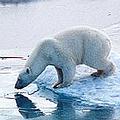 世界自然保育聯盟(IUCN)2日發表瀕危物種《紅皮書》(Red List),其中北極熊與河馬首度被列為有滅絕危機之物種。此項全球動植物現況的權威性評估報告顯示,地球生物多樣性持續惡化,歸咎於人類生活對地球的衝擊。
世界自然保育聯盟(IUCN)2日發表瀕危物種《紅皮書》(Red List),其中北極熊與河馬首度被列為有滅絕危機之物種。此項全球動植物現況的權威性評估報告顯示,地球生物多樣性持續惡化,歸咎於人類生活對地球的衝擊。
IUCN《紅皮書》共針對40,177種生物進行評估,其中有約40%被列入受威脅的名單,達16,119種。其中針對鯊魚、魟魚和淡水魚類的首次評估結果顯示牠們面臨的絕種危機越來越高,而沙漠瞪羚與多種地中海植物也逐漸失去生存的戰場。IUCN正式發表的瀕絕生物總數是784種,另外還有65種已在野外失去蹤跡,僅有人工圈養或人工培育的個體。
由於全球暖化衝擊到地球上一些極冷的地方,因而北極熊(學名Ursus maritimus)今年面臨的滅絕危機更加升高。北極熊原本被IUCN列為「視保育情況而定」(conservation dependent)的生物,如今則被歸類為「受威脅」(threatened)與「脆弱」(Vulnerable)等級。
北極熊的生存有賴於在浮冰上獵捕海豹,是為適應北極海洋環境而高度特化的生物。而由於全球暖化,極地區的夏季海洋浮冰預計在未來50到100年間減少50%到100%,因此估計北極熊將於未來45年內減少30%以上數量。
 另外,河馬(學名Hippopotamus amphibius)也遇到了麻煩。河馬是非洲最有名的動物之一,由於在剛果民主共和國境內的分佈數量大幅減少,首次被列入受威脅名單,被歸類為「脆弱」等級。
另外,河馬(學名Hippopotamus amphibius)也遇到了麻煩。河馬是非洲最有名的動物之一,由於在剛果民主共和國境內的分佈數量大幅減少,首次被列入受威脅名單,被歸類為「脆弱」等級。
1994年時,剛果民主共和國境內的河馬數量在非洲排名第二,有30,000頭,僅次於尚比亞的40,000頭,但卻在短時間內大量減少了95%,首要元兇是為了取得河馬肉與河馬牙而脫序的狩獵行為。
IUCN秘書長史坦納(Achim Steiner)表示︰「我們需要更多的保育措施。過去成功的保育經驗告訴我們,當生物多樣性流失與生物滅絕的慘劇在我們眼前展開時,我們不應該只當消極的旁觀者。」
2006年IUCN瀕危物種《紅皮書》內容已上網,可點選此處。
The polar bear and the hippopotamus are listed for the first time as vulnerable species at risk of extinction in the 2006 Red List of Threatened Species released today by the IUCN-World Conservation Union. The ongoing decline of the Earth's biodiversity due to the impact of humans upon life on Earth is revealed in this authoritative assessment of the global status of plants and animals.
About 40 percent of the 40,177 species assessed using the IUCN Red List criteria, are now listed as threatened with extinction - a total of 16,119 species. A first assessment of ocean sharks and rays, and freshwater fishes shows them increasingly at risk of extinction. Desert gazelles and Mediterranean plants are also losing the battle to survive. The total number of species declared officially by the IUCN Extinct is 784 and a further 65 are only found in captivity or cultivation.
Because global warming is affecting some of the coldest places on Earth, the polar bear, Ursus maritimus, is at greater risk of extinction this year. Previously listed by IUCN as a conservation dependent species, the polar bear moves into the threatened categories and has been classified as Vulnerable.
In polar regions, summer sea ice is expected to decrease by 50-100 percent over the next 50-100 years. Polar bears are dependent upon Arctic ice-floes for hunting seals and highly specialized for life in the Arctic marine environment, so they are predicted to suffer more than a 30 percent population decline in the next 45 years.
The common hippopotamus, Hippopotamus amphibius, is also in trouble. One of Africa's best known animals, it is listed as threatened for the first time and is now classified as Vulnerable, primarily because of a catastrophic decline in the Democratic Republic of the Congo (DRC).
In 1994 the DRC had the second largest hippo population in Africa – 30,000 after Zambia’s 40,000 - but numbers have plummeted by 95 percent. The decline is due to unregulated hunting for meat and the ivory of their teeth.
IUCN Director General Achim Steiner said, "What we need is more of conservation measures. Conservation successes document that we should not be passive by-standers in the unfolding tragedy of biodiversity loss and species extinction."
To view the 2006 IUCN Red List of Threatened Species, click here.






